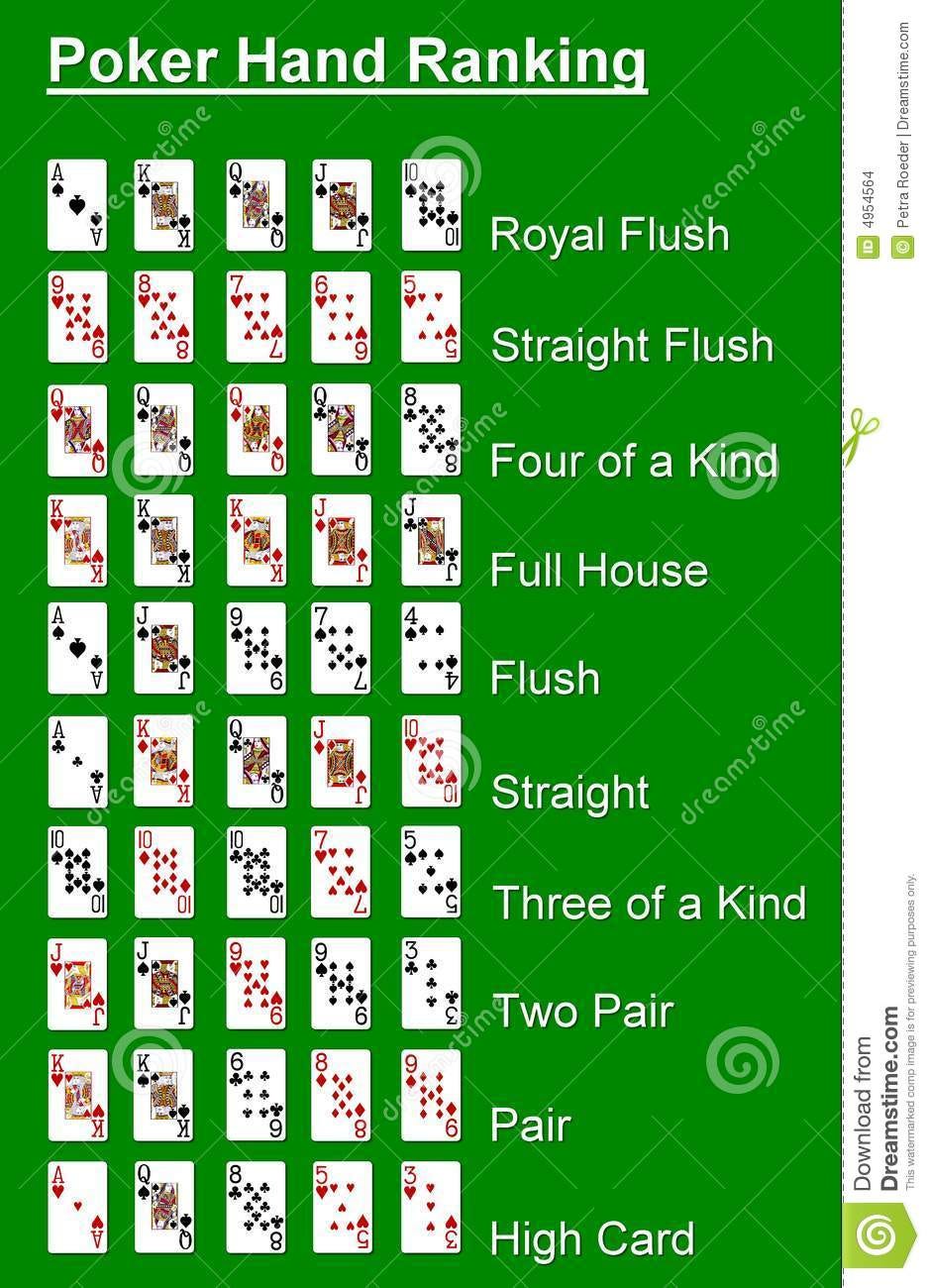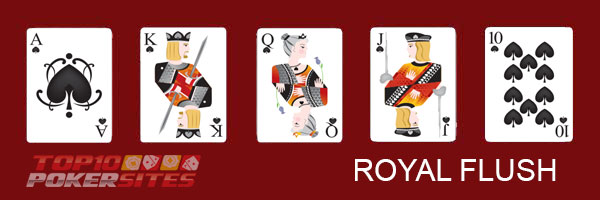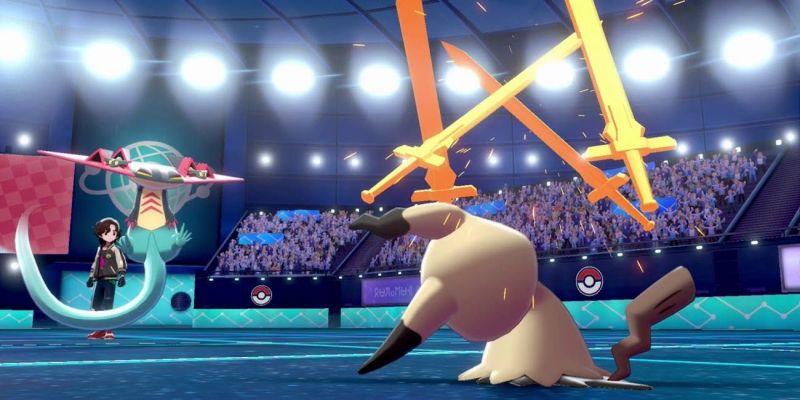Poker Hands Ranked Highest To Lowest
Here is a comprehensive list of poker hands in order from highest to lowest ranking. If you are new to the game of poker, learning the different poker hands is a great first step in learning how to beat your opponents with the cards you are dealt. The strongest poker hand is the royal flush.
View full poker hands cheat sheet. A royal flush is an ace high straight flush. For example, A-K-Q-J-10 all of diamonds. A straight flush is a five-card straight, all in the same suit. For example, 7-6-5-4-3 all of spades. Four of a kind, or quads, are. Two Pair is a hand that contains two cards of one rank, two cards of another, and one card of a third rank (the kicker). It sits below Three of a Kind and above One Pair. Each Two Pair is ranked by its highest-ranking pair, then by its lowest-ranking pair. Two Pair hands that differ by suit alone rank equally. This is the highest poker hand. It consists of ace, king, queen, jack and ten, all in the. Pusoy dos (or Filipino poker, also known as chikicha or sikitcha), a variation of big two, is a popular type of 'shedding' card game with origins in the islands of the Philippines in Calauag, Quezon Province.The object of the game is to be the first to discard one's hand by playing them to the table. If one cannot be first to play all cards, then the aim is to have as few cards as possible.
Pusoy dos (or Filipino poker, also known as chikicha or sikitcha), a variation of big two, is a popular type of 'shedding' card game with origins in the islands of the Philippines in Calauag, Quezon Province. The object of the game is to be the first to discard one's hand by playing them to the table. If one cannot be first to play all cards, then the aim is to have as few cards as possible. Cards can be played separately or in certain combinations using poker hand rankings. Games of Pusoy Dos can be played by three or four people.
Rules[edit]
Suit order[edit]
From lowest to highest, clubs (♣), spades (♠), hearts (♥) and diamonds (♦), with the 2♦ being the highest card and the 3♣ the lowest.
Another variation of the suit order is: From lowest to highest, diamonds (♦), clubs (♣), hearts (♥) and spades (♠), with the 2♠ being the highest card and the 3♦ the lowest. Filipino Americans in the Bay Area call this variation 'Daly City High School.'
Card combinations[edit]
There are various types of card combinations that can be used in play.
Single card: Cards rank from 2 (highest) to 3 (lowest). Between cards of the same rank, the higher suit beats the lower suit. That is, a 5♦ beats a 5♥.
Pair: A pair of equally ranked cards. Between pairs of the same rank, the pair with the higher suit wins. That is, a 7♠-7♦ beats a 7♥-7♣.
Three of a kind: Three equally ranked cards. This is a variation of game play and may be excluded or included as a valid card combination.
Five-card hand: Any five-card combination following the poker hand rankings. From highest to lowest, valid poker hands include:
- Royal flush (jack to 2 with the same suit)
- Straight flush (any straight cards with the same suit)
- Four of a kind (plus an additional card/a Kicker)
- Full House (any three cards of the same number with any two cards of the same number)
- Flush (same suit)
- Straight (any straight cards)
- Two-Pair
- Three Kings (no such thing)
The playable combinations are similar to poker hands, but there are vital differences. Unlike poker, there are no 'two pair' combinations, and although a four of a kind needs a fifth card to be complete, a three of a kind cannot be accompanied by extra cards (except for a full house when played as a five-card hand).
Also, a combination can only be beaten by a better combination with the same number of cards: A single card can be beaten only by a single card, a pair by a pair, a three of a kind by a three of a kind, and a five-card hand by a five-card hand.[1]
Dealing and playing[edit]
The dealer shuffles the deck and then deals one card at a time either clockwise or counter-clockwise[2][unreliable source?] until each player has 13 cards (52 cards / 4 players = 13 cards per player). In games with three people, either 39 or 51 cards can be dealt (13 or 17 cards per player). In some variations, the deck must be reshuffled if any player is dealt all four twos.
The game begins when the player holding the lowest card, which is the 3♣ depending upon the suit order being played, plays that card or a valid card combination including that card. The card combination should be placed faced up in the center of the table. Play then proceeds clockwise or counterclockwise. The next person must play a higher combination of the same number of cards or pass (play no cards). Once a player passes, he cannot return until a new round has started. If all players pass, the person who last put down a card combination starts a new round by playing any card or valid card combination.
All players are entitled to know the number of cards each player has in hand at any time, and you must answer truthfully if asked.[2]
Winning and scoring[edit]
The first person to get rid of all his/her cards wins, and game play stops at this point. If you cannot be first to play all your cards, then your aim is to have as few cards as possible at the end of the game. In some variations of the game, game play continues until only one person still has cards in hand.
Game scoring can involve penalty points, like Big Two, or positive points.[3][unreliable source?] In versions of the game where game play ends when a person wins, the winner is awarded one point and the losers no points. In versions of the game where game play continues until only one person has cards, the winner is awarded five points, the second-place finisher is awarded three points, and the third-place finisher is awarded one point.
Variations[edit]
In the South West of England, this is known as Frazz's game, the suits are ranked Diamonds, Clubs, Hearts, Spades and instead of using a points system the losing player becomes the dealer. The four of a kind hand cannot be made into a 5 card hand.
See also[edit]

References[edit]
- ^https://web.archive.org/web/20120728075545/http://www.pusoydos.com/. Archived from the original on July 28, 2012. Retrieved April 7, 2013.Missing or empty
title=(help)[unreliable source?] - ^ abhttp://www.pagat.com/climbing/bigtwo.html
- ^http://www.pagat.com/climbing/bigtwo.html#scoring%20vars
Standard Poker Hand Rankings
There are 52 cards in the pack, and the ranking of the individual cards, from high to low, is ace, king, queen, jack, 10, 9, 8, 7, 6, 5, 4, 3, 2. There is no ranking between the suits - so for example the king of hearts and the king of spades are equal.
A poker hand consists of five cards. The categories of hand, from highest to lowest, are listed in the chart below. Any hand in a higher category beats any hand in a lower category (so for example any three of a kind beats any two pairs). Between hands in the same category the rank of the individual cards decides which is better, as described in more detail below.
In games where a player has more than five cards and selects five to form a poker hand, the remaining cards do not play any part in the ranking. Poker ranks are always based on five cards only.
1. Royal Flush
This is the highest poker hand. It consists of ace, king, queen, jack and ten, all in the same suit. As all suits are equal, all royal flushes are equal.
2. Straight Flush

Five cards of the same suit in sequence - such as J-10-9-8-7. Between two straight flushes, the one containing the higher top card is higher. An ace can be counted as low, so 5-4-3-2-A is a straight flush, but its top card is the five, not the ace, so it is the lowest type of straight flush. The cards cannot 'turn the corner': 4-3-2-A-K is not valid.
3. Four of a kind
Four cards of the same rank - such as four queens. The fifth card can be anything. This combination is sometimes known as 'quads', and in some parts of Europe it is called a 'poker', though this term for it is unknown in English. Between two fours of a kind, the one with the higher set of four cards is higher - so 3-3-3-3-A is beaten by 4-4-4-4-2. It can't happen in standard poker, but if in some other game you need to compare two fours of a kind where the sets of four cards are of the same rank, then the one with the higher fifth card is better.
4. Full House
This consists of three cards of one rank and two cards of another rank - for example three sevens and two tens (colloquially known as 'sevens full' or more specifically 'sevens on tens'). When comparing full houses, the rank of the three cards determines which is higher. For example 9-9-9-4-4 beats 8-8-8-A-A. If the threes of a kind were equal, the rank of the pairs would decide.
5. Flush
Five cards of the same suit. When comparing two flushes, the highest card determines which is higher. If the highest cards are equal then the second highest card is compared; if those are equal too, then the third highest card, and so on. For example K-J-9-3-2 beats K-J-7-6-5 because the nine beats the seven.
K-J-7-6-5 because the nine beats the seven. 6. Straight
Five cards of mixed suits in sequence - for example Q-J-10-9-8. When comparing two sequences, the one with the higher ranking top card is better. Ace can count high or low in a straight, but not both at once, so A-K-Q-J-10 and 5-4-3-2-A are valid straights, but 2-A-K-Q-J is not. 5-4-3-2-A is the lowest kind of straight, the top card being the five.
7. Three of a Kind
Three cards of the same rank plus two other cards. This combination is also known as Triplets or Trips. When comparing two threes of a kind the hand in which the three equal cards are of higher rank is better. So for example 5-5-5-3-2 beats 4-4-4-K-Q. If you have to compare two threes of a kind where the sets of three are of equal rank, then the higher of the two remaining cards in each hand are compared, and if those are equal, the lower odd card is compared.8. Two Pairs
A pair is two cards of equal rank. In a hand with two pairs, the two pairs are of different ranks (otherwise you would have four of a kind), and there is an odd card to make the hand up to five cards. When comparing hands with two pairs, the hand with the highest pair wins, irrespective of the rank of the other cards - so J-J-2-2-4 beats 10-10-9-9-8 because the jacks beat the tens. If the higher pairs are equal, the lower pairs are compared, so that for example 8-8-6-6-3 beats 8-8-5-5-K. Finally, if both pairs are the same, the odd cards are compared, so Q-Q-5-5-8 beats Q-Q-5-5-4.
9. Pair
A pair is a hand with two cards of equal rank and three other cards which do not match these or each other. When comparing two such hands, the hand with the higher pair is better - so for example 6-6-4-3-2 beats 5-5-A-K-QPoker Hands Ranked Highest To Lowest Time
. If the pairs are equal, compare the highest ranking odd cards from each hand; if these are equal compare the second highest odd card, and if these are equal too compare the lowest odd cards. So J-J-A-9-3 beats J-J-A-8-7 because the 9 beats the 8.10. High Card
Five cards which do not form any of the combinations listed above. When comparing two such hands, the one with the better highest card wins. If the highest cards are equal the second cards are compared; if they are equal too the third cards are compared, and so on. So A-J-9-5-3 beats A-10-9-6-4 because the jack beats the ten.
Poker Hands Ranked Highest To Lowest Points
A plastic wallet sized Poker Card Ranking card is available at F.G. Bradley’s stores or online here.